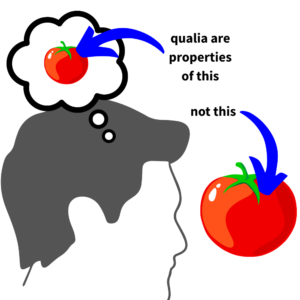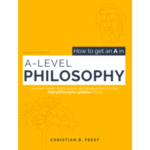The technical definition of qualia (singular: quale) according to the A-level philosophy specification is:
intrinsic and non-intentional phenomenal properties that are introspectively accessible.

But it’s really not that complicated. It just means qualia are properties of our experience.
So when you look at a ripe tomato, for example, you experience red qualia. The qualia is the redness of your experience or perception of the tomato, which is different from the physical wavelengths of light or whatever that make the tomato itself red. That inner sensation – the experience of “redness” is a quale.
Another example of qualia would be the notes you hear when listening to music. These subjective and introspective properties – what it feels like inside your mind – are again different from the objective and external properties (i.e. the vibration of air molecules).
Or, when you rub your hand over sandpaper, you would experience a rough feeling in your fingertips – that rough feeling is the qualia.
Again, qualia are properties of your experience – they’re private to you. So although we can both listen to the same piece of music, look at the same tomato, or touch the same piece of sandpaper, we each experience our own qualia inside our minds.
| Objective | Qualia |
|---|---|
| The wavelengths of light that bounce off the tomato | The redness of the image in your mind when you look at the tomato (red qualia) |
| The vibrations in the air caused by the speakers | The notes you hear in your mind when you listen to the music (e.g. F# qualia) |
| The coarse grit and uneven texture of the sandpaper’s surface | The rough feeling you experience in your fingers when touching sandpaper (rough tactile qualia) |
So going back to the AQA definition:
- Phenomenal properties: This is the point about qualia being properties of experience, i.e. that they are properties of the perception of a thing, not the thing itself.
- Introspectively accessible: You become aware of qualia by turning your attention inward – i.e. by paying attention to what’s in your mind. Qualia are part of your subjective and private experience rather than the public and objectively measurable external world.
- Intrinsic: This means qualia are built into the experience itself – they’re not dependent on anything outside the experience.
- Non-intentional: Qualia aren’t about anything in the way beliefs, desires, or thoughts are. They don’t have “intentional content” or represent external things – they simply occur as raw sensations (see intentionality for more).
Philosophical implications
What’s interesting about qualia is that they seem completely unlike ordinary, physical properties. You can measure height with a ruler, for example. Or, if we’re purely talking about the objective wavelengths of light, we can measure those with a spectrometer.
But qualia can’t be measured or observed except by the person experiencing them. For example, when I’m looking at the red tomato, it’s not like my physical brain turns red – but something within my mind is red: the qualia. That redness isn’t objectively ‘out there’ in the world in any measurable form – it’s part of how the world appears to me.
The weirdness of qualia forms the basis of several arguments which attempt to show there is more to the mind than just physical stuff. For more on this, see the hard problem of consciousness and dualism.
 The philosophy textbook written in plain English!
The philosophy textbook written in plain English!